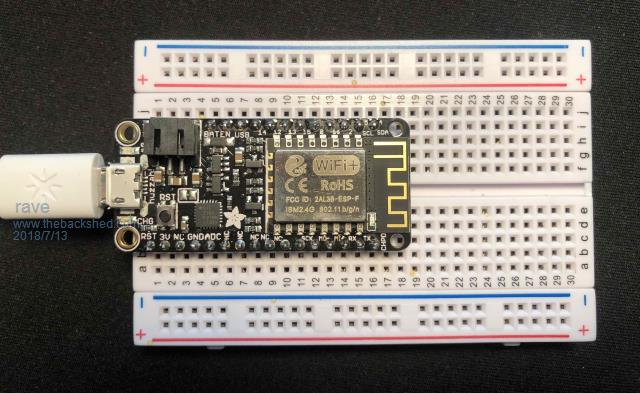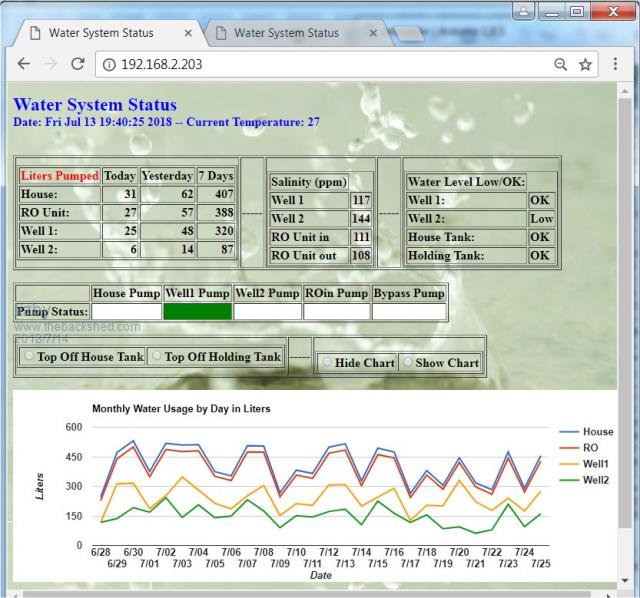
|

|
Forum Index : Microcontroller and PC projects : esp8266 basic
| Author | Message | ||||
| RyanHammond Newbie Joined: 29/03/2018 Location: United StatesPosts: 15 |
This may be of interest to folks here that have used esp8266 basic combined with the micromite for projects. esp8266 basic revamp |
||||
palcal Guru Joined: 12/10/2011 Location: AustraliaPosts: 2006 |
Seems like that is 'cicciocb' I remembered the avatar he was a member here but hasn't posted since Feb 2015. "It is better to be ignorant and ask a stupid question than to be plain Stupid and not ask at all" |
||||
| CYBERLAB Newbie Joined: 08/08/2017 Location: MexicoPosts: 26 |
Hello everyone, I was working on a design that included a micromite screen and a wifi module, I found this page https://micropython.org/ and I was surprised at how easy and economical the project came out using an esp8266 and a screen oled and micropython, I suggest you take a look when you have some free time. |
||||
| CaptainBoing Guru Joined: 07/09/2016 Location: United KingdomPosts: 2171 |
quite like that micropython but a major hurdle (for me at least) is not being breadboard friendly. Aimed at prototypers/makers this makes things so much easier. Pretty much everything starts out on a breadboard. Having to put jumpers on the board to connect it to a breadboard makes things a bit messy and increases the chances of inadvertent shorts or disconnects. my 2p |
||||
| CYBERLAB Newbie Joined: 08/08/2017 Location: MexicoPosts: 26 |
I used a node mcu and a Wi-Fi kit 32 for prototype of my project and I did not have any problem of false contacts with the breadboard, I had never used micropython, and the truth is I'm empirical when it came to programming it was so simple that in a week I had working my project, which had started a long time ago with a micromite and I could not finish it (because I'm not very good at programming) |
||||
| rave Newbie Joined: 24/02/2018 Location: United StatesPosts: 28 |
I also used an ESP8266 and flashed Lua with Node MCU https://nodemcu-build.com/index.php. The first flash attempt did not work. I figured I needed to erase the device first. So I wrote the following script on my Mac to simplify this process: #!/bin/bash # http://nodemcu.readthedocs.io/en/latest/en/flash/ if [ "$#" == 0 ] then echo "Usage: flash.sh firmware.bin" exit 1 fi if [ ! -f "$1" ] then echo "Cannot read $1" exit 1 fi ESP8266USB=$(ls /dev/cu.SLAB_USBtoUART) if [ "$ESP8266USB" != "/dev/cu.SLAB_USBtoUART" ] then echo "ESP8266 USB not connected" 1>&2 exit 1 fi echo "To enable ESP8266 firmware flashing GPIO0 pin must be pulled low before the device is reset" echo "Press ENTER to continue" read echo "Determining flash capacity:" esptool.py --port $ESP8266USB flash_id echo "Press ENTER to continue" read echo "Erasing flash:" esptool.py --port $ESP8266USB erase_flash echo "Flashing:" esptool.py --port $ESP8266USB write_flash -fm qio 0x00000 $1 echo "OK" I am disappointed with Lua on this device, because it's too small and the language has been compromised to remove features, such as floating point support and even bit operations  and instead you'll have to use a bit-fiddling library which must be installed on top of all things. Installing just a few libraries breaks the build, because it just does not fit in 512MB. I needed TLS and it did not fit and instead you'll have to use a bit-fiddling library which must be installed on top of all things. Installing just a few libraries breaks the build, because it just does not fit in 512MB. I needed TLS and it did not fit  . .Also, I could not get any terminal program work properly with my ESP8266 except 'screen'. Even the instructions to use 'screen' are incorrect (resetting the device when connected kills it). I haven't tried micropython, had anyone had luck with that to run a TLS server? I would  to see MMBASIC run on ESP8266 to see MMBASIC run on ESP8266  Do you agree or do you think it is not possible? - Rob |
||||
| plover Guru Joined: 18/04/2013 Location: AustraliaPosts: 306 |
CaptainBoing I have had this model(s) in my brain for some time, and others too, I agree many or not really "breadboard" friendly, they are not "Legoish" enough. that aside, would you rough out on a back of an envelope what you think would be a nice little "breadboard converter board and I will DEX it up as part of my learning exercise in AutoTRAX for production no bigger than 100x100mm I would expect smaller. rave My understanding, which is rather minimal despite I think I have one of the models in a box here somewhere, of the EXP8266 range is that there is such a widespread range of implementations. You have alluded to that already. I agree that MMBasic would be a very interesting exercise, and some initial ground work could be done by forum members those who have the interest, time and free of having to make a living as well (me included). Do we have enough knowledge to figure out if it is a sensible thing to put MMBasic on the device? Thinking about The "monster" MMBasic implementation boards available, is that not and indication that for one the ESP8266 simply do not have enough memory? Anyway where can we find the specsheet for the chips used and spechseet/manual for the ESP8266. I have done a quick search and did not find much. If it has not already been done I would say we, the lesser smart ones, could do some initial research perhaps guided by Geoff/matherp as to what points we need to consider and perhaps procede under their guidance and see if we can make a decision. There are enough smart ones here to help us fumblers out. Who know it could be a bit of fun too?  |
||||
| JohnS Guru Joined: 18/11/2011 Location: United KingdomPosts: 4126 |
Maybe try a bigger build on the readily-available 1MB esp8266 boards? John |
||||
| JohnS Guru Joined: 18/11/2011 Location: United KingdomPosts: 4126 |
They have plenty of memory - commonly 1MB but earlier ones 512KB. There are full SDKs, spec sheets, etc if you look but someone would need to spend plenty of time and effort to port MMBasic. It's not apparent who or whether there's any real point in yet another porting effort - what big advantage is there for all the effort? If it were to involve Geoff or Peter then it reduces their time to do other things, of course. John |
||||
| Geoffg Guru Joined: 06/06/2011 Location: AustraliaPosts: 3308 |
It is just not possible to port the interpreter to everyone's favourite chip, there are just too many of them out there. Long ago I made the decision to focus on running MMBasic on a small number of chips and because of that I was able to ensure that it was done in the best way possible. Also, you do have to ask why? For example, the ESP8266 and Micromite only cost a few dollars each and both together is not a complex circuit. Why try to squeeze the Micromite code into the ESP8266 with all the bugs and compromises that would entail? Leave the chips separate so that each can do what they are good at. Geoff Graham - http://geoffg.net |
||||
| rave Newbie Joined: 24/02/2018 Location: United StatesPosts: 28 |
@plover thanks for chiming in! Agreed. The ones that are breadboard-friendly typically are 512K, for example the Feather ESP8266 from Adafruit, which has 9 GPIO pins, power and serial via USB, 100mA LiPoly charger and still relatively cheap at $17:  Given the trouble with this thing I'm thinking about upgrading to a newer ESP32 with 4MB flash, e.g. https://www.adafruit.com/product/3405 which is a $20 breadboard-friendly feather board or https://www.adafruit.com/product/3269 which is a $15 development board but looks too chunky for breadboard use IMO. Plenty of smart people on this forum who can pull this off!  But I suspect the return on investing time on this might not be worth it. How large would the MMBASIC community grow, compared say to MicroPython and C coders using the ESP8266/ESP32? But I suspect the return on investing time on this might not be worth it. How large would the MMBASIC community grow, compared say to MicroPython and C coders using the ESP8266/ESP32?- Rob |
||||
| plover Guru Joined: 18/04/2013 Location: AustraliaPosts: 306 |
I have spent 2 hours plus on the internet and found some more details, and lucky enough to find some overview articles etc. Also a bit on the history. I feel the development of the ESP8266 demonstrates what happens if you try to branch out. Where would MMBasic be if Geoff had tried to cover more chips. There may be smart people here who could do the porting, but I think they are also smart enough to figure out that is a very big job, I would expect you need to be absolutely passionate to embark on the job. One important thing when you are done how long will there be support. I will make some experimental layouts in DEX but only as educational objects. a form of bigger parts, like an ESP actually incorporated a a library part, quite good fun. I have some ideas in that direction. Having WiFi on a MM is enticing but I don't know how much it involves but seems to open possibilities for simple BT/WiFi operation. The reading I did indicated the Generation 1 had the very wide boards making bread boarding inconvenient, yes but also some peaople quickly figured out that two small boards interlocked or not could be spaced and having the ESP8266 span the gap. A sturdy basboard and a form of gleu to stick down the small boards forming a nice solid setup. BUt then the later implementations has shrunk a lot so would you not buy those instead  |
||||
| lizby Guru Joined: 17/05/2016 Location: United StatesPosts: 3466 |
Because of the ESP8266 complication of relinquishing control often enough so that it doesn't drop wifi, I would strongly recommend that anyone looking at this use the dual core ESP32 instead. I am finding the ESP-32S ESP32 NodeMCU Development Board at $5.25 USD satisfactory. On a breadboard, there is one row available on either side of the module. I'd love to see MMBasic on it, but can't really see anyone putting in the time to port it. PicoMite, Armmite F4, SensorKits, MMBasic Hardware, Games, etc. on fruitoftheshed |
||||
| lizby Guru Joined: 17/05/2016 Location: United StatesPosts: 3466 |
I just ported a picaxe web server to the ESP32 (in C, which I once programmed a lot in, but not in 30 years). Got the module on Tuesday, and got this far today (Friday). I subscribed to Rui Santos' ESP32 tutorial, and it got me to where I needed to be. The html template code is stored in a 24LC64 eeprom, with tokens (~##, e.g., ~01, ~20) where variable values are to be placed. This isn't yet connected to any sensors. The project was for controlling a water delivery system with 2 saline wells, a saline holding tank, a reverse osmosis filter, a drinkable holding tank, and various sensors and pumps. The time is retrieved using sntp whenever a connection is made to the (internet-connected) router.  The ESP32 seems to me a quite capable chip. Whether it has the capacity to have MMBasic installed, I don't know. Having wifi and bluetooth is a plus. PicoMite, Armmite F4, SensorKits, MMBasic Hardware, Games, etc. on fruitoftheshed |
||||
| CaptainBoing Guru Joined: 07/09/2016 Location: United KingdomPosts: 2171 |
me likey! |
||||
| The Back Shed's forum code is written, and hosted, in Australia. | © JAQ Software 2025 |